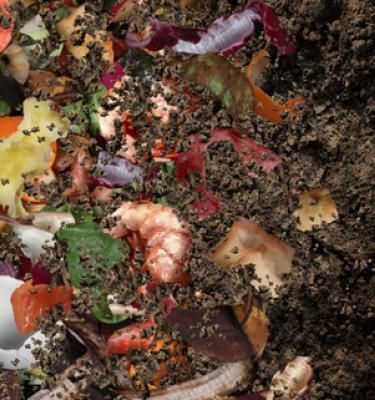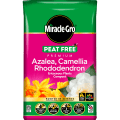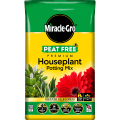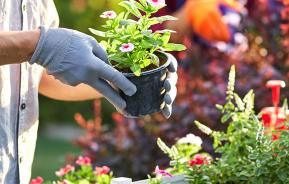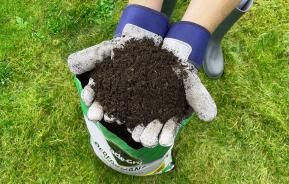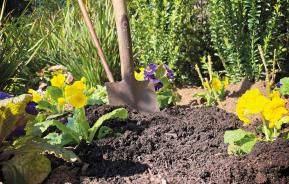Making your own compost is one of the best things you can do for your soil, and it’s something every gardener should know how to do.
To help you get started, we’ve put together everything you need to know about compost and how to make it.
Essential equipment
To start the process of making compost, you will need:
- Plant material
- Cardboard and paper
- Pallets or a compost bin
- Plastic sheeting
- Garden fork or aerating tool
All about compost

Compost is what happens when plant material breaks down and decomposes, turning into a rich, brown, crumbly soil-like material. As a gardener, adding compost to your soil is one of the best ways to look after it.
Compost improves soil structure, helping sandy soils to retain moisture and heavy soils to drain better. Compost also boosts the number of beneficial bacteria and fungi in the soil. All of this makes it easier for plants to take up the nutrients in the soil, allowing them to grow bigger and healthier.
Garden compost is made from a combination of ‘green’ plant material, like leaves, soft green stems and grass clippings, and ‘brown’ material like woody stems, cardboard and crumpled-up paper.
The brown material is very important to the composting process. Without it, the soft green plant cuttings would tend to compact down into a slimy, airless mush. Because the brown materials break down more slowly and retain their structure for longer, they help to let air into the heap, providing vital oxygen for the worms, bacteria and other soil organisms that do the actual decomposition work.
When adding material to your compost heap, aim for a 50/50 mix of brown and green material.
What is organic compost?
Composts certified as organic have to meet strict regulations regarding the level of man-made chemicals they contain, whereas non-organic composts have no such restrictions. Although home-made compost is likely to contain some chemicals, such as residues from fertilisers or pesticides, making your own DIY compost allows you to control what you put into it, allowing you to be as organic as possible.
Compost bins and compost heaps
The simplest version of a compost heap is just that – plant material piled up in a heap and left to break down. However, providing a structure for your compost heap makes it easier to keep things tidy. You can use wooden pallets to make a framework for your compost heap. Make the structure at least 1m x 1m (3.5ft x 3.5ft) square, with three fixed sides and a removable section at the front for access. If you have space, it’s a good idea to make two or even three compost heaps and rotate them, leaving one heap to break down while you fill up the others.
If you don’t have space for a large compost heap, you can buy a compost bin that will work just as well, although the compost may take longer to break down in this.
Ideally, place your heap or bin directly on the soil, so that soil bacteria and worms can get into the compost. If this isn’t possible and you have to place it on a hard surface, add a shovelful of soil along with the plant material to get the composting process going.
The bacteria and fungi that break down plant material into compost prefer a constant temperature and an environment that is not too hot, dry or wet. Place your compost heap or bin in a shady spot and cover open heaps with a sheet of heavy black plastic to keep out the rain.
How to make compost
When you’re wondering ‘How do I make my own compost?’, the first thing you need to know is what can and can’t be composted. Here are a few pointers.
What to compost
- Soft green plant stems.
- Leaves.
- Grass clippings.
- Cardboard and paper.
- Shredded or chopped up woody stems (shredding or chopping allows them to break down faster).
- Annual weeds.
- Vegetable peelings.
What not to compost
- Cooked food, dairy products or meat (this could attract rats).
- Diseased plants.
- Autumn leaves – these take a long time to break down in a compost heap and are much better used to make leaf mould.
- Perennial weeds such as dandelions, bindweed, brambles – these can all re-grow from small pieces of root. Domestic compost heaps don’t get hot enough to kill these weeds, so send them to your local council’s green waste disposal site instead.
Turn your compost at least once a month if possible, using a garden fork to loosen it up. This helps to aerate the compost and allows it to break down faster. Compost bins are not as easy to aerate as compost heaps, which is why the compost tends to break down slower in these bins, but many models come with an aerating tool that allows you to get some air in.
Take care when turning your compost in early spring, as hedgehogs and other wildlife may still be hibernating in it.
Making leaf mould
Although it’s fine to add a few leaves to your compost heap or bin during the year, don’t put your autumn leaf fall in.
In large quantities, leaves will take a long time to break down, slowing up the composting process. Instead, put them into black bin bags, with a few holes cut in the bags to allow moisture to get in, and leave them somewhere out of sight. In a year or so, the leaves will break down into dark crumbly leaf mould, which makes the most fantastic soil improver.
Making your own compost lets you turn old, discarded plant material into something that your soil will love. Start making your own compost today!
